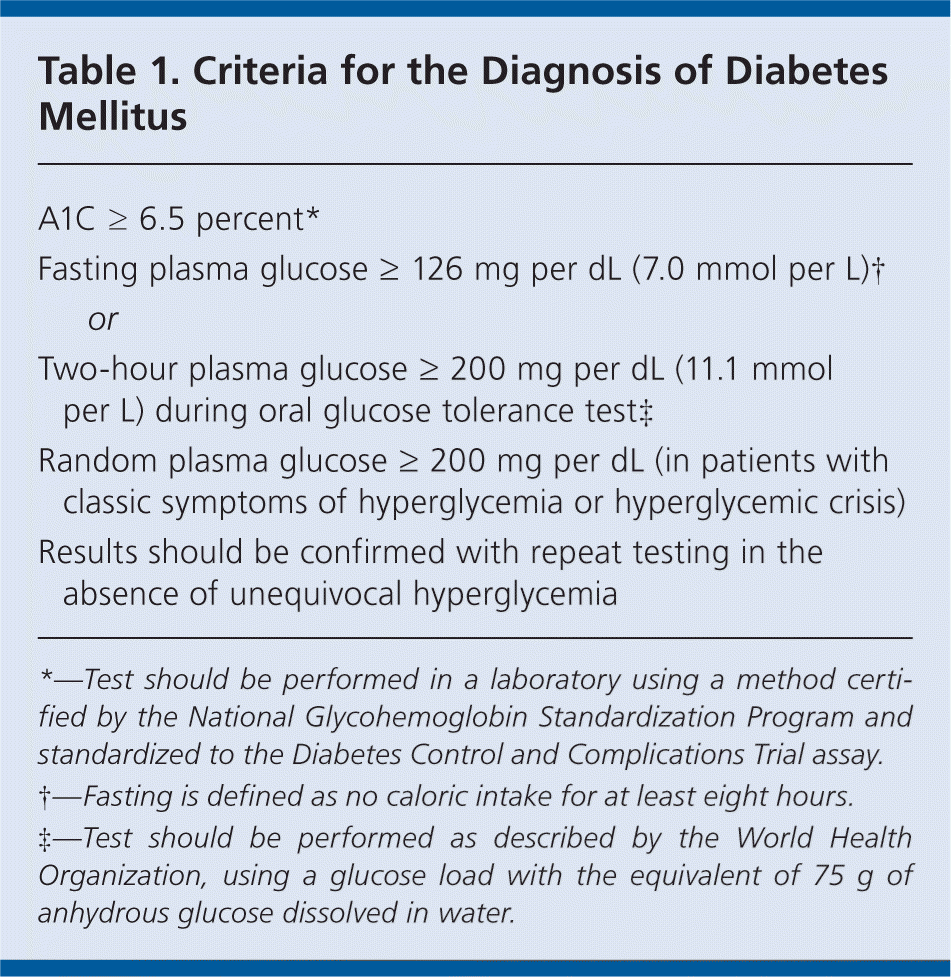
Am Fam Physician. 2012;85(5):514-515
Guideline source: American Diabetes Association
Evidence rating system used? Yes
Literature search described? No
Guideline developed by participants without relevant financial ties to industry? No
Published source:Diabetes Care, January 2011
Caring for patients with diabetes mellitus requires addressing many issues beyond glycemic control. To help physicians provide optimal care for these patients, the American Diabetes Association (ADA) releases annual revisions to its clinical practice recommendations for standards of medical care. The recommendations include screening, diagnostic, and therapeutic actions that have been shown or are believed to have beneficial outcomes in patients with diabetes. Current criteria for the diagnosis of diabetes are listed in Table 1.

| A1C ≥ 6.5 percent* | |
| Fasting plasma glucose ≥ 126 mg per dL (7.0 mmol per L)† | |
| or | |
| Two-hour plasma glucose ≥ 200 mg per dL (11.1 mmol per L) during oral glucose tolerance test‡ | |
| Random plasma glucose ≥ 200 mg per dL (in patients with classic symptoms of hyperglycemia or hyperglycemic crisis) | |
| Results should be confirmed with repeat testing in the absence of unequivocal hyperglycemia |
Summary of Revisions
The 2011 revisions to the ADA recommendations include small changes related to new evidence released since the previous version. In addition, some sections have undergone major changes. “Detection and Diagnosis of Gestational Diabetes Mellitus” now includes the 75-g oral glucose tolerance test and new diagnostic criteria for gestational diabetes. The new criteria will significantly increase the prevalence of gestational diabetes, mostly because only one abnormal value is needed for a diagnosis instead of two. These changes were made in response to worldwide increases in obesity and diabetes rates, and with the goal of improving outcomes for women and their infants. “Hypertension/Blood Pressure Control” reflects new evidence emphasizing the importance of setting individual blood pressure goals for each patient. “Nephropathy Screening and Treatment” now includes a table of suggested management options for complications in patients with advanced chronic kidney disease. The “Children and Adolescents” section no longer provides lower limits for A1C targets, and includes a discussion on appropriate individualization and safety. The recommendations specify that glycemic goals in children should be set after weighing the benefits of a lower A1C level against the risks of hypoglycemia. Finally, the “Strategies for Improving Patient Care” section reflects growing evidence that supports the effectiveness of restructuring systems of chronic care delivery. To improve care, the recommendations suggest implementing components of the Chronic Care Model and the Patient Centered Medical Home initiative.
Detection and Diagnosis of Gestational Diabetes
At the first prenatal visit, patients with risk factors should be screened for undiagnosed type 2 diabetes using standard diagnostic criteria. Pregnant women who are not known to have diabetes should be screened for gestational diabetes at 24 to 28 weeks' gestation with a 75-g oral glucose tolerance test. A diagnosis of gestational diabetes is made if any of the following levels of plasma glucose are exceeded: ≥ 92 mg per dL (5.1 mmol per L) when fasting, 180 mg per dL (10 mmol per L) at one hour, or 153 mg per dL (8.5 mmol per L) at two hours. At six to 12 weeks postpartum, women with gestational diabetes should be screened for persistent diabetes. In women with a history of gestational diabetes, lifelong screening for diabetes at least every three years is recommended.
Testing for Diabetes in Asymptomatic Patients
Physicians should consider testing for type 2 diabetes and assessing the risk of future diabetes in asymptomatic persons of any age who are overweight or obese (i.e., body mass index ≥ 25 kg per m2) and who have one or more additional risk factors for diabetes. In patients with no risk factors, testing should start at 45 years of age. Appropriate tests include A1C measurement, fasting plasma glucose measurement, or a two-hour 75-g oral glucose tolerance test. Testing should be repeated every three years if results are normal. If patients are found to have an increased risk of future diabetes, physicians should identify and treat risk factors for cardiovascular disease.
Prevention/Delay of Type 2 Diabetes
Patients with impaired glucose tolerance, impaired fasting glucose, or an A1C level of 5.7 to 6.4 percent should be referred to an ongoing support program. Effective support programs should target weight loss of 7 percent of body weight and physical activity of at least 150 minutes of moderate activity (e.g., walking) per week. Because of the potential cost savings of prevention, support programs should be covered by third-party payers. Follow-up counseling should be performed to improve the chance of successful prevention. Metformin (Glucophage) therapy should be considered for the prevention of type 2 diabetes in persons at highest risk, including those with multiple risk factors, especially persons who demonstrate progression of hyperglycemia (e.g., A1C level ≥ 6 percent) despite lifestyle interventions. Patients with prediabetes should be screened annually for diabetes.
